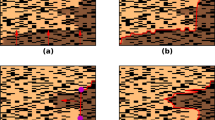Abstract
In a recent paper, we described the behavior of the cardiac electric near-field, E, parallel to the tissue surface during continuous conduction. We found that the tip of E describes a vector-loop during depolarization with the peak field, \(\hat E\), pointing opposite to the direction of propagation, \(\varphi _{I_m } \). Experimentally recorded loop morphologies of E, however, frequently showed significant deviations from the theoretically predicted behavior. We hypothesized that this variety of morphologies might be caused by conduction obstacles at a microscopic size scale. This study examines the influence of obstacles on the morphology of vector loops of E and whether the peak of distorted loops remains a reliable indicator for the direction of propagation. We used a computer model of a sheet of cardiac tissue with a central conduction obstacle immersed in an unbounded volume conductor. We studied the loop morphologies of E and the differences between the intracellularly determined direction of propagation, \(\varphi _{I_m } \), and the direction of \(\hat E\), ϕ {E}. Distortions of the vector loop were morphologically similar to those observed experimentally. Differences between \(\varphi _{I_m } \) and ϕ {E} were less than 18° at all observation sites. The obstacle led to deformations of the loop morphology, particularly during the initial and terminal phases, and to a lesser degree near the instant of \(\hat E\). We concluded that \(\hat E\) is a reliable indicator of \(\varphi _{I_m } \). © 2003 Biomedical Engineering Society.
PAC2003: 8719Hh, 8710+e, 8719Nn
Similar content being viewed by others
References
Azene, E. M., N. A. Trayanova, and E. Warman. Wave front-obstacle interactions in cardiac tissue: A computational study. Ann. Biomed. Eng. 29:35–46, 2001.
Cabo, C., A. M. Pertsov, W. T. Baxter, J. M. Davidenko, R. A. Gray, and J. Jalife. Wave-front curvature as a cause of slow conduction and block in isolated cardiac muscle. Circ. Res. 75:1014–1028, 1994.
Geselowitz, D. B., R. C. Barr, M. S. Spach, and W. T. Miller, III. The impact of adjacent isotropic fluids on electrograms from anisotropic cardiac muscle—A modeling study. Circ. Res. 51:602–613, 1982.
Goette, A. et al.Increased expression of extracellular signal-regulated kinase and angiotensin-converting enzyme in humanatria during atrial fibrillation. J. Am. Coll. Cardiol. 35:1669–1677, 2000.
Hocini, M., P. Loh, S. Y. Ho, D. Sanchez-Quintana, B. Thibault, J. M. T. De-Bakker, and M. J. Janse. Anisotropic conduction in the triangle of Koch of mammalian hearts: Electrophysiologic and anatomic correlations. J. Am. Coll. Cardiol. 31:629–636, 1998.
Hofer, E., G. Urban, M. S. Spach, I. Schafferhofer, G. Mohr, and D. Platzer. Measuring activation patterns of the heart at a microscopic size scale with thin-film sensors. Am. J. Physiol. 266:H2136–H2145, 1994.
Hofer, E., G. Mohr, G. Plank, and I. Schafferhofer. Electrical fields of anisotropic discontinuous cardiac conduction—An experimental approach. Biomed. Tech. 42:17–20, 1997.
Hooke, N., C. S. Henriquez, P. Lanzkron, and D. Rose. Linear algebraic transformations of the bidomain equations: Implications for numerical methods. Math. Biosci. 120:127–145, 1994.
Isomoto, S. et al.The influence of advancing age on the electrophysiological changes of the atrial muscle induced by programmed atrial stimulation. Jpn. Circ. J. 56:776–782, 1992.
Luo, C., and Y. Rudy. A model of the ventricular cardiac action potential. Depolarization and their interaction. Circ. Res. 68:1501–1526, 1991.
Maglaveras, N., J. M. T. de Bakker, F. J. L. van Capelle, C. Pappas, and M. J. Janse. Activation delay in healed myocardial infarction: A comparison between model and experiment. Am. J. Physiol. 269:H1441–H1449, 1995.
Mohr, G., E. Hofer, and G. Plank. A new real-time mapping system to detect microscopic cardiac excitation patterns. Biomed. Instrum. Technol. 33:455–461, 1999.
Pertsov, A. In: Discontinuous Conduction in the Heart, edited by P. M. Spooner, R. W. Joyner, and J. Jalife. Armonk: Futura, 1997, pp. 273–293.
Plank, G., and E. Hofer. Model study of vector-loop morphology during electrical mapping of microscopic conduction in cardiac tissue. Ann. Biomed. Eng. 28:1244–1252, 2000.
Plank, G., and E. Hofer. The use of cardiac electric near-field measurements to determine activation times. Ann. Biomed. Eng. 31:1076–1077, 2003.
Spach, M. S., and P. C. Dolber. Relating extracellular potentials and their derivatives to anisotropic propagation at microscopic level in human cardiac muscle: Evidence for electrical uncoupling of side-to-side fiber connections with increasing age. Circ. Res. 58:356–371, 1986.
Spooner, P. M., R. W. Joyner, and J. Jalife. Discontinuous Conduction in the Heart. Armonk: Futura, 1997.
Starobin, J. M., Y. I. Zilberter, E. M. Rusnak, and C. F. Starmer. Wavelet formation in excitable cardiac tissue: The role of wavefront-obstacle interactions in initiating high-frequency fibrillatory-like arrhythmias. Biophys. J. 70:581–594, 1996.
Suenson, M. Interaction between ventricular cells during the early part of excitation in the ferret heart. Acta Physiol. Scand. 125:81–90, 1985.
Author information
Authors and Affiliations
Rights and permissions
About this article
Cite this article
Plank, G., Vigmond, E., Leon, L.J. et al. Cardiac Near-Field Morphology During Conduction Around a Microscopic Obstacle—A Computer Simulation Study. Annals of Biomedical Engineering 31, 1206–1212 (2003). https://doi.org/10.1114/1.1615573
Issue Date:
DOI: https://doi.org/10.1114/1.1615573




